
Vinita is a city and county seat of Craig County, Oklahoma, United States. As of the 2010 census, the population was 5,743, a decline of 11.22 percent from the figure of 6,469 recorded in 2000.

American Electric Power (AEP), is a major investor-owned electric utility in the United States, delivering electricity to more than five million customers in 11 states.
Tulsa is the second-largest city in the state of Oklahoma and 45th-most populous city in the United States.
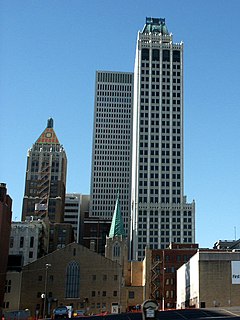
The Mid-Continent Tower is a 36-story skyscraper located at 401 South Boston Avenue in downtown Tulsa, Oklahoma. At 156 meters (513 ft) in height, it is the fourth-tallest building in Tulsa and fifth-tallest in Oklahoma. Faced with bright white terra cotta and crowned with a distinctive copper roof, it is one of the city's most recognizable buildings. The design is unique because the first 16-story structure was built in 1918. The top 20 stories comprise a separate structure, cantilevered over the first 66 years later. The architects of the addition matched the design of the original structure so carefully that the result is considered a single structure. It is included as a contributing structure in Tulsa's Oil Capital Historic District.

The Philtower Building is a historic building located at 427 South Boston Avenue in Tulsa, Oklahoma.
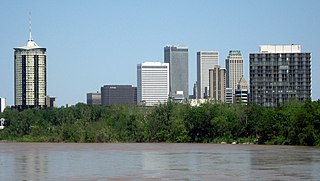
Tulsa is the second-largest city in the state of Oklahoma. It has many diverse neighborhoods due to its size.
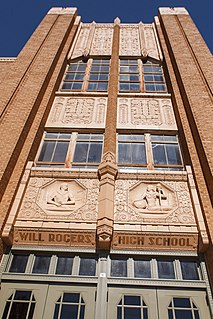
Will Rogers Middle and High School, located at 3909 E. 5th Place in Tulsa, Oklahoma, was built by Tulsa Public Schools in 1939 using WPA workers and designed by Joseph R. Koberling, Jr. and Leon B. Senter. It was named for the humorist Will Rogers, who died in 1935, along with Wiley Post in a plane crash. Significant additions were made to the original structure in 1949 and 1964. The alterations were in keeping with the original design and did not detract from the school's architectural or historical significance. It has been called "... one of the best examples of Art Deco high school architecture...in the United States.
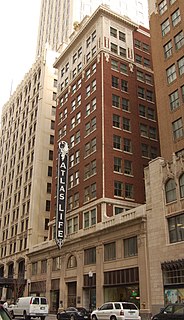
The Atlas Life Building is a historic twelve-story building in downtown Tulsa, Oklahoma. Designed by the firm Rush, Endacott and Rush, the building was completed in 1922. It is located at 415 S. Boston Avenue, sandwiched between the Philtower and Mid-Continent Tower. On May 19, 2009, it was added to the U.S. National Register of Historic Places. Originally an office building, it was converted to hotel use in 2010.
Downtown Tulsa is an area of approximately 1.4 square miles (3.6 km2) surrounded by an inner-dispersal loop created by Interstate 244, US 64, and US 75. The area serves as Tulsa's financial and business district, and is the focus of a large initiative to draw tourism, which includes plans to capitalize on the area's historic architecture. Much of Tulsa's convention space is located in downtown, such as the Tulsa Performing Arts Center and the Tulsa Convention Center, and the BOK Center. Prominent downtown sub-districts include the Blue Dome District, the Tulsa Arts District, and the Greenwood Historical District, which includes the site of ONEOK Field, a baseball stadium for the Tulsa Drillers opened in 2010.

The Oklahoma Natural Gas Company Building is a historic building in Tulsa, Oklahoma, at 624 South Boston Ave. It was one of the first local Art Deco buildings built in the new Art Deco style, along with the Public Service of Oklahoma Building. This choice by the relatively conservative utility companies made the style acceptable in the city, with many Art Deco buildings built subsequently in Tulsa. The building was designed by Frank V. Kirshner and Arthur M. Atkinson. It was built of reinforced concrete, and clad in buff brick, except for the lower two stories, which are clad in limestone. The verticalness of the building is emphasized by piers rising the entire height of the facade with windows placed between the piers.

Central High School is the oldest high school in Tulsa, Oklahoma. It was founded in 1906 as Tulsa High School, and located in downtown Tulsa until 1976. The school now has a 47-acre (19 ha) campus in northwest Tulsa. Tulsa Central is part of the Tulsa Public Schools, Oklahoma's largest school district, and is a public school for students from grades 9 through 12. Since 1997 it has served as a fine and performing arts magnet school.
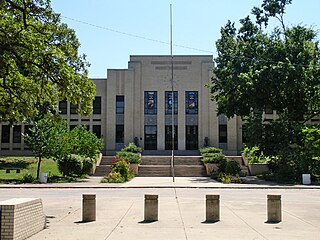
Daniel Webster High School is a high school in Tulsa, Oklahoma. It is part of the Tulsa Public Schools, and is a public school for students from grades 9 through 12. The school opened in 1938 in the West Tulsa section of the city, and is housed in a PWA-style Art Deco building designed by architects Arthur M. Atkinson, John Duncan Forsyth, Raymond Kerr, and William H. Wolaver.
The following is a timeline of the history of the city of Tulsa, Oklahoma, United States.

The Oil Capital Historic District (OCHD) is an area in downtown Tulsa, Oklahoma that commemorates the success of the oil business in Tulsa during the early 20th century. During this period, Tulsa was widely known as "The Oil Capital of the World." The area is bounded by 3rd Street on the north and 7th Street on the south, Cincinnati Avenue on the east and Cheyenne Avenue on the west.
Joseph R. Koberling Jr. was a Hungarian-American architect. Born in Budapest, Hungary, he emigrated to the United States, first to San Francisco, then, in 1917, to Tulsa, Oklahoma where he was a student of noted art teacher, Adah Robinson. He was in the first graduation class of Tulsa Central High School. He was then educated at the Armour Institute in Chicago, Illinois. He received a Bachelor of Arts in Architecture in 1925. He returned to Tulsa, where he began practicing. He received his Oklahoma license in architecture in 1929, which he maintained until his death.
Adah Matilda Robinson was an American artist, designer and teacher, who influenced many other artists, especially architects, during the first half of the 20th century. Born in Indiana, she was educated in art schools in the Chicago area, as well as receiving private lessons from noted artist there during the late 19th century. Adah moved with her family to Oklahoma City, where she began teaching art. She moved to Tulsa and became the first art teacher at Tulsa High School. One of the pupils in her first class was the aspiring artist, Bruce Goff. Later, she taught another student, Joseph R. Koberling, Jr., who would also become a noted architect. In 1928, she was hired as the founder and chairperson of the Art Department at the University of Tulsa.

The Southwestern Bell Telephone Company constructed a two-story building in 1924. The structure, which encompassed 18,726 square feet (1,739.7 m2), was to house the main dial equipment for the new automatic dial equipment that the company had introduced to Tulsa in November 1924. The architecture of the building was Gothic Style. In 1930, the company added four floors to the top of the 1924 structure to house its divisional offices and toll terminal equipment needed for the underground cable that connected Tulsa with Oklahoma City. The 1930 addition was constructed in Zig Zag Art Deco Style.

The Gillette-Tyrrell Building is a building in downtown Tulsa, Oklahoma. It was begun in 1929 by two Tulsa oilmen, J. M. Gillette and H. C. Tyrrell. They initially planned to construct a three-story office building at 432 S. Boulder Avenue, topped by a ten-story hotel, but these plans were canceled during the Great Depression and they stopped construction at the third floor. In 1931, they sold it to the Knights of Pythias, who decided to complete it as an office building and renamed it the Pythian Building.
The Tulsa Club Building is an 11-story structure that stands on the northwest corner of Cincinnati Avenue and East Fifth Street, inside the Oil Capital Historic District of Tulsa, Oklahoma, United States. Designed by Bruce Goff and constructed in 1927 by the architectural firm Rush, Endacott and Rush, it was a joint venture of the Tulsa Club and the Tulsa Chamber of Commerce.

Leon Bishop Senter was an American architect who worked primarily in Oklahoma. Although not formally educated in architecture, he became Oklahoma's first licensed architect in 1925 and designed several buildings on the National Register of Historic Places.















